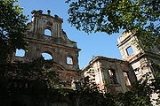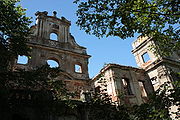
Chróstnik
Encyclopedia
Chróstnik ' is a village in the administrative district of Gmina Lubin
, within Lubin County
, Lower Silesian Voivodeship
, in south-western Poland. Prior to 1945 it belonged to Germany
. It is approximately 7 kilometres (4 mi) south-west of Lubin
, and 66 kilometres (41 mi) west of the regional capital Wrocław.
 The village is originally mentioned as Old Polish Chrustenik (meaning shrubbery or brushwood) with the parish church
The village is originally mentioned as Old Polish Chrustenik (meaning shrubbery or brushwood) with the parish church
under the patronage
of a Boleslaw von Brauchitsch in 1222. Members of the Brauchitsch noble family were landowners here up to 1633. The Baroque
Brauchitschdorf Palace was erected from 1723 to 1728 and enlarged in 1909. After World War II
the Red Army
plundered the building.
Gmina Lubin
Gmina Lubin is a rural gmina in Lubin County, Lower Silesian Voivodeship, in south-western Poland. Its seat is the town of Lubin, although the town is not part of the territory of the gmina....
, within Lubin County
Lubin County
Lubin County is a unit of territorial administration and local government in Lower Silesian Voivodeship, south-western Poland. It came into being on January 1, 1999, as a result of the Polish local government reforms passed in 1998. The county covers an area of...
, Lower Silesian Voivodeship
Lower Silesian Voivodeship
Lower Silesian Voivodeship, or Lower Silesia Province , is one of the 16 voivodeships into which Poland is currently divided. It lies in southwestern Poland...
, in south-western Poland. Prior to 1945 it belonged to Germany
Germany
Germany , officially the Federal Republic of Germany , is a federal parliamentary republic in Europe. The country consists of 16 states while the capital and largest city is Berlin. Germany covers an area of 357,021 km2 and has a largely temperate seasonal climate...
. It is approximately 7 kilometres (4 mi) south-west of Lubin
Lubin
Lubin is a town in Lower Silesian Voivodeship in south-western Poland. From 1975–1998 it belonged to the former Legnica Voivodeship. Lubin is the administrative seat of Lubin County, and also of the rural district called Gmina Lubin, although it is not part of the territory of the latter,...
, and 66 kilometres (41 mi) west of the regional capital Wrocław.
History

Parish church
A parish church , in Christianity, is the church which acts as the religious centre of a parish, the basic administrative unit of episcopal churches....
under the patronage
Patronage
Patronage is the support, encouragement, privilege, or financial aid that an organization or individual bestows to another. In the history of art, arts patronage refers to the support that kings or popes have provided to musicians, painters, and sculptors...
of a Boleslaw von Brauchitsch in 1222. Members of the Brauchitsch noble family were landowners here up to 1633. The Baroque
Baroque architecture
Baroque architecture is a term used to describe the building style of the Baroque era, begun in late sixteenth century Italy, that took the Roman vocabulary of Renaissance architecture and used it in a new rhetorical and theatrical fashion, often to express the triumph of the Catholic Church and...
Brauchitschdorf Palace was erected from 1723 to 1728 and enlarged in 1909. After World War II
World War II
World War II, or the Second World War , was a global conflict lasting from 1939 to 1945, involving most of the world's nations—including all of the great powers—eventually forming two opposing military alliances: the Allies and the Axis...
the Red Army
Red Army
The Workers' and Peasants' Red Army started out as the Soviet Union's revolutionary communist combat groups during the Russian Civil War of 1918-1922. It grew into the national army of the Soviet Union. By the 1930s the Red Army was among the largest armies in history.The "Red Army" name refers to...
plundered the building.
Notable people
- House of BrauchitschBrauchitschBrauchitsch is the surname of a German noble family, first documented in the 13th century at the Silesian village of Chrustenik . Notable members are:* Walther von Brauchitsch , Wehrmacht field marshal...
- Benjamin SchmolckBenjamin SchmolckBenjamin Schmolck was a German Lutheran composer of hymns.He was born a pastor's son in Brauchitschdorf , Silesia. After attending the gymnasium in Liegnitz , he studied theology at the University of Leipzig from 1693 to 1697...
, hymnHymnA hymn is a type of song, usually religious, specifically written for the purpose of praise, adoration or prayer, and typically addressed to a deity or deities, or to a prominent figure or personification...
composerComposerA composer is a person who creates music, either by musical notation or oral tradition, for interpretation and performance, or through direct manipulation of sonic material through electronic media...
, born December 21, 1672, died February 12, 1737 in ŚwidnicaSwidnicaŚwidnica is a city in south-western Poland in the region of Silesia. It has a population of 60,317 according to 2006 figures. It lies in Lower Silesian Voivodeship, being the seventh largest town in that voivodeship. From 1975–98 it was in the former Wałbrzych Voivodeship...
(Schweidnitz)

